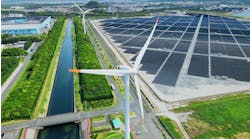Energy, the environment, and decarbonization are topics headlining many conversations today as the world witnesses or experiences firsthand the effects of climate change, both immediate and long term. In the U.S., the Biden administration has committed significant resources to spur climate action, including research and pilot programs in advanced technologies, such as those integral to smart buildings and communities. SBT spoke with Ram Narayanamurthy, Emerging Technologies Program manager at the Department of Energy (DOE), about promising clean tech and the government’s role in steering the built environment toward more efficient infrastructure that benefits more people. Narayanamurthy brings two decades of industry experience in the development and deployment of building technologies, including leadership roles at the Electric Power Research Institute, Ice Energy, and EchoFirst.
SBT: Can you highlight a few DOE initiatives related to smart buildings and technologies?
Narayanamurthy: Our GEB (grid-interactive efficient building) initiative has been going on for about three or four years; we’re looking at how buildings work more efficiently using technology, but also how they connect to the larger energy system, whether it’s a grid or edge-of-the-grid energy systems. We are working on the value of GEBs and how they provide value to the customer—by customer, I usually mean the building occupant or property owner, but it could also be the developer or homebuilder.
We are looking at ways customers adopt renewables, in-home batteries, and heat pumps, and how all of those systems work together so that A) we are our enabling the zero-carbon grid for the future, and B) we are minimizing the extent of grid addition that might be required.
We are working on technologies like smart [electrical] panels and 120-volt cooktops that would avoid the need for a panel upgrade. We’re looking at different technologies that make GEBs better, but also more cost-effective for future.
I’ll also highlight the Connected Communities initiative, a $60 million-plus initiative that we launched last year. It’s a cohort of 10 projects around the country that spans the spectrum from energy efficiency to building electrification, demand flexibility, and looking at how new technologies integrate into distribution management systems and provide more flexibility to the grid while keeping customers comfortable and enabling customer benefit.
One example is a project with Edo Energy, in Spokane, Wash. They’ve been able to eliminate gas pipelines to a large commercial building campus by using heat recovery chillers and a substantial amount of thermal energy storage for both heating and cooling. Heating storage is not a common application, but ultimately that’s what [enabled them] to avoid building a new substation that was planned near the campus. This project looks at how building technologies that provide demand flexibility and controls can enable the larger energy system.
Another example [from this cohort] is two communities of zero-energy homes in southern California. One of these communities has batteries, and every home has solar, two-directional electric vehicle charging, high-efficiency heat pumps, and heat pump water heaters. We’re looking at how these energy systems can provide resilience to the customer through a combination of better insulation technology and better control of batteries, water heating, and indoor temperatures. Another part of the project looks at connecting them to a microgrid, which has solar and [energy] storage built in at the community level. That way, they can ride through interruptions like PSPS [public safety power shut-offs] for fire safety. These [shut-offs] are more common now, and this community is located in a high wildfire [risk] area. These are examples of how we are using connected communities to look at how smart buildings, residential or commercial, can enable the future grid.
How does government funding play a role? Does it invest in these initiatives?
The government is not going to help a homebuilder build homes, but what we are investing in is the above and beyond. For example, collecting data as part of [these initiatives] is important because we need to have the [information and analysis] to scale these communities. We invest in controls that provide grid integration, which might not have been original part of the campus or building design. More importantly, we invest in R&D elements, such as design analysis and technology transfer.
The government is not going to help a homebuilder build homes, but what we are investing in is the above and beyond.
Will the government mandate adoption of smart technologies in a manner similar to how energy efficiency is mandated in public buildings, but also for privately owned buildings?
Energy efficiency has been driven by its overall cost-effectiveness—that energy efficiency ultimately reduces the size of the grid or the amount of generation that’s required. Most energy efficiency goes through a cost-effectiveness test. If other controls technologies can provide that same benefit, we are not going to mandate it. A lot of voluntary programs will happen and ultimately, at some point, some make their way into codes and standards.
Take the example of the smart thermostats, like the Nest. A lot of utility programs provide an incentive for those devices, but on the condition that the utilities can tap into those devices to do precooling, set the temperature back, or set the temperature higher when there is a crisis on the grid. That’s an incentive program.
But building codes like California’s Title 24 requires some of these connected thermostats to be installed in buildings. The code has found that it is cost-effective and can be implemented in buildings.
Do private companies, such as architecture and development firms, also require a business case to implement advanced building technologies?
Architects and developers might implement smart building technologies because there’s a customer demand for, as an example, a smart conference room that can be scheduled or can dim its lights when nobody is around. Or there’s a more customer-friendly way of operating the building, such as a network of sensors that measures temperature, humidity, and light throughout a large commercial building, aggregates that data, and sends it back to the building control system so the building can be operated more efficiently, comfortably, and healthy.
On the energy side, a lot of the value derives from the value to the energy system itself, or the grid. Implementation of demand-response technologies is going to be based on their cost-effectiveness or how much the building owner can get in terms of rebates or reduced electric rates from the utility to implement those technologies.
Besides competitions and requests for proposals, how can companies apply for funding referenced in recent legislation, such as the Bipartisan Infrastructure Law (or Infrastructure Investment and Jobs Act) and Inflation Reduction Act?
The funding in the BIL and IRA that is to be distributed is specific to certain initiatives. For example, there’s an open funding opportunity through the BIL for school districts to apply for upgrading their buildings. While I can’t speak for the entirety of the organization, most of the funding is going to be through competitive funding opportunities.
What research areas and ideas in clean building tech and smart buildings do you find promising?
One of our initiatives is the EAS-E (Equitable and Affordable Solutions to Electrification) Prize. It is for enhancing the affordability of electrification in buildings looking at building-level solutions for connected technologies and low-power solutions that can help with decarbonization. It is an open competition for people to come with ideas that can help avoid grid upgrades, electrical system upgrades, and building upgrades.
Finally, what do you think about the application of artificial intelligence in building systems?
New buildings have sophisticated control systems that can take on a greater amount of sophisticated software algorithms. But most of the buildings we have today are existing buildings. Their control systems are old and not as interoperable, the hardware is outdated, and many of the sensors don’t work. Until we can get those systems upgraded, it is going to be hard to run sophisticated algorithms that enable AI in those buildings—it’s really hard to run AI algorithms on a 2010 Pentium computer, right?
It’s really hard to run AI algorithms on a 2010 Pentium computer, right?
And many buildings have control systems that are much older, with much less processing power. So the big barrier is getting the hardware in existing buildings upgraded to allow more sophisticated algorithmic optimization. This will be the biggest challenge as we work toward decarbonization.
This interview has been edited and condensed for clarity.
For more news, projects, and profiles in the smart buildings ecosystem, subscribe to the SBT newsletter and follow us on LinkedIn, Twitter, and Facebook.



